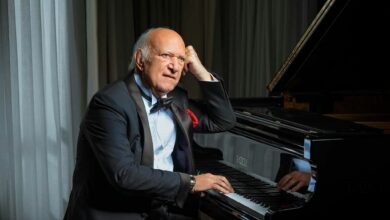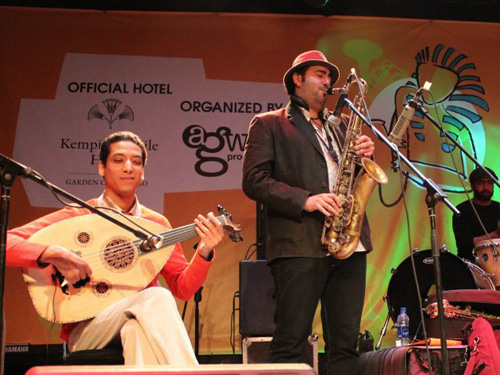The traditional map of Khedival Cairo marks Mohamed Ali Street as its northeastern gate. Aside from a bit of restoration work and a handful of superficial renovations, the history-laden street looks much the same as it always has. Socially, however, much has changed.
The site of a dynamic social history, Mohamed Ali Street evokes a vibrant memory of the city's 20th century cultural and artistic landscape.
Stretching over 1.5km and known locally as shari’ al-fann, or the street of the arts, Mohamed Ali is relatively new compared to the millenary history of Cairo. Its story goes back to the era of Khedive Ismail (1863-79), when the city underwent an urban transformation to emulate European capitals like Paris and London. Straight boulevards and tidy sidewalks were important signs of this transformation, and they meant destroying part of the old street, including the ancient Qusun Mosque. The desire for an ostentatious modernity was manifested in the elimination of the visible "backwardness" of run-down houses and messy street markets.
Over the course of the 20th century, Mohamed Ali Street became a local center for instrument making, bands, musicians, dancers and singers from all over Cairo and even from villages where the arts were not considered a stable profession.
The street eventually became a refuge for young female dancers who were forced to leave their homes because belly dancing was viewed as dishonorable. Mohamed Ali Street offered them a hospitable environment in addition to social protection. Professional managers interfaced between dancers and clients, organizing performances and negotiating fees.
The presence of so many artists and musicians manifested itself on street. In her thesis, "Dancing in the Betwixt and Between: Feminity and Embodiment in Egypt," Noha Roushdy writes about how singers, musicians and dancers used to advertise by leaning out of balconies overlooking the main street and singing at passers-by.
Iconic Egyptian and Arab popular music and dance acts like the Hasaballah family band, Farid el-Atrash, Laila Mourad, Samia Gamal, Mohamed Roushdy, Mohamed Shawky, Adaweya, Sabrine, Tahia Carioca, and Fifi Abdou developed their talents on Mohamed Ali Street, often performing in the renowned Qahwaet el-Tigara, which also housed heated political debates.
The Sherifeen broadcasting building was right round the corner and it musicians and composers lived and rehearsed next to it in order to take part in the numerous and influential radio programs of the 1960s to the 1970s. Many of their recordings are still played on Egyptian radio.
Perhaps unsurprisingly, Mohamed Ali Street has made repeated appearances in Egyptian literature, poetry, cinema, and music. Niazi Mostafa's 1945 film Shari’ Mohamed Ali (Mohamed Ali Street) starring Abdel Ghani el-Sayed and Horrya Mohamed was one of the first movies set there. But it was the 1959 movie Shari’ el-Hob (Street of Love) that more successfully depicted the vibrant soul of the street, with key roles played by the unforgettable Abdel Halim Hafez and Nagwa Fouad, herself a “daughter” of Mohamed Ali Street who maintains her fame as a dancer and actress until today. And then there is the famous Khali Balak min Zuzu (Take Care of Zuzu), starring the diva Souad Hosni, which tells the story of a street stigmatized by society for its belly dancers.
The street maintained its fame as a cultural playground, but like the rest of the city, underwent major transformations in the late 1970s. President Anwar el-Sadat’s Open Door policies, which brought massive foreign investment into Egypt, led to rapid social and economic change and resulted in the breakdown of the codes of conduct in the entertainment industry.
Suq el-musiqyyin (The musicians market), which was once a place for common entertainment practices for weddings and celebrations, turned into a cabaret business where local art served new purposes. In this new world, traditional music and dance were transformed into an orientalized folklore to meet the expectations of foreigners and to attract easy money.
In the last 20 years, artisanal instrument making and live performances decreased in value, especially as new, Western music overtook the local music market. Recycled furniture and kiosks of metal plates slowly made their way into the street’s traditional arcades.
“Now it is all business and no fun,” says Khamees Hankash, a tabla player who still runs his 60-year-old family percussion shop on Mohamed Ali Street. “Nowadays I have to go to Spain or Italy to find a dancer to perform with,” he says, showing DVDs featuring his latest performance with European artists.
“Experience, family traditions and fame gained through live performances had a value back in the golden days, but now it is all about DJs, electronic standard bases, video clips and ageless pop heroines.”
Mohamed Saeed Mostafa, known as Aam Khamees, runs a hidden workshop on the side of a stairway on Mohamed Ali Street, which can easily be found with a little guidance from people in the neighborhood. He spends the day cutting, bending and smoothing the wood circles that form the main part of the traditional bendir (doff), a craft he learned from his father. Many musicians still visit him today and testify to the quality of his instruments.
Besides making a few doffs per day, Aam Khamees specializes in repairing all kinds of instruments using basic tools, a rare skill in today’s market. Musicians are grateful for the survival of his craft.
"For me, it means that I don't have to buy a new instrument whenever the old one is broken or doesn't work properly," says Nour Ashour, a saxaphonist with el-Dor el-Awal and Ressala, two independent oriental jazz groups. "Musicians are often attached to their own instrument and prefer getting it fixed rather than trowing it away."
Today, Khamees' workshop has become a museum-like space full of instruments, tools, scrap wood, screws, cigarette butts, and framed newspaper articles and photos of famous dancers and singers. His shop tells the story of a street characterized by a wide variety of reactions, from nostalgia to stigma, but most of all by transformation.




